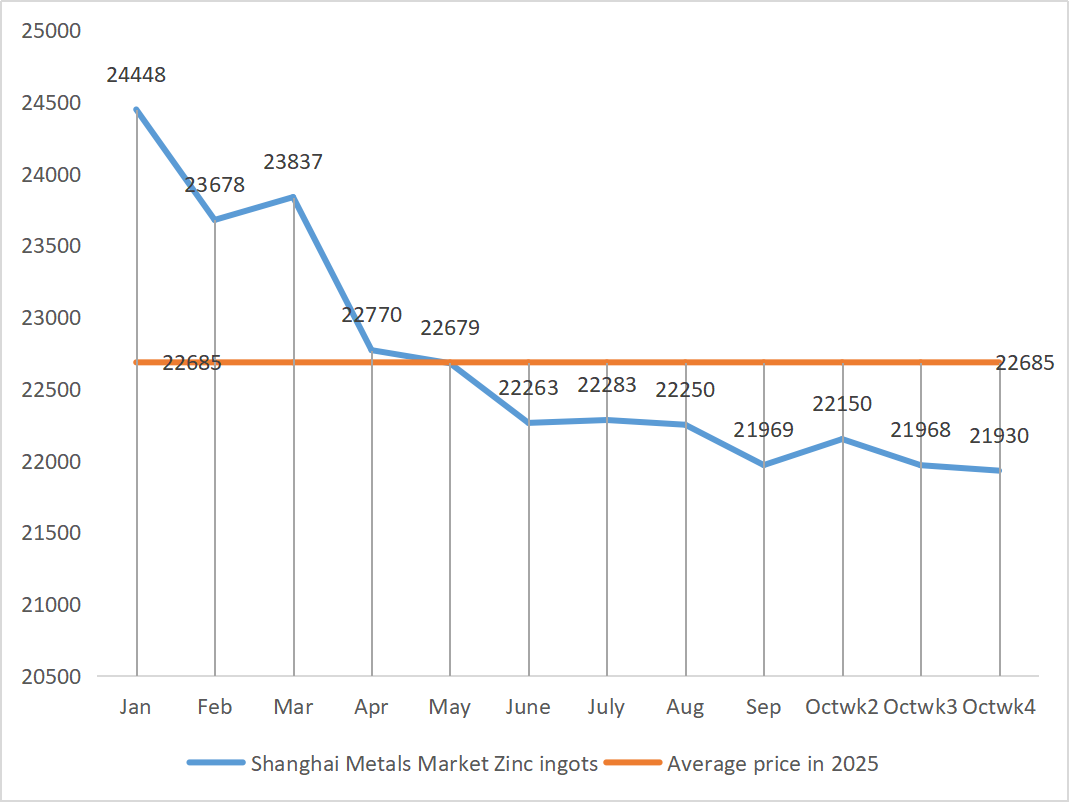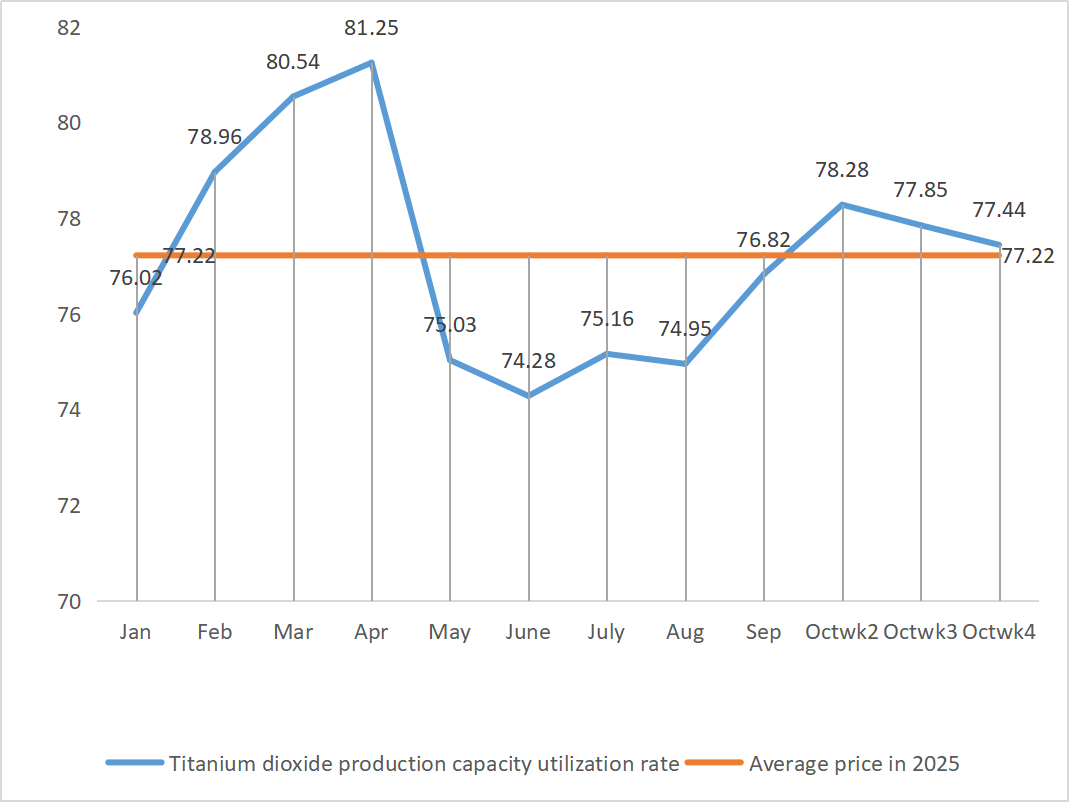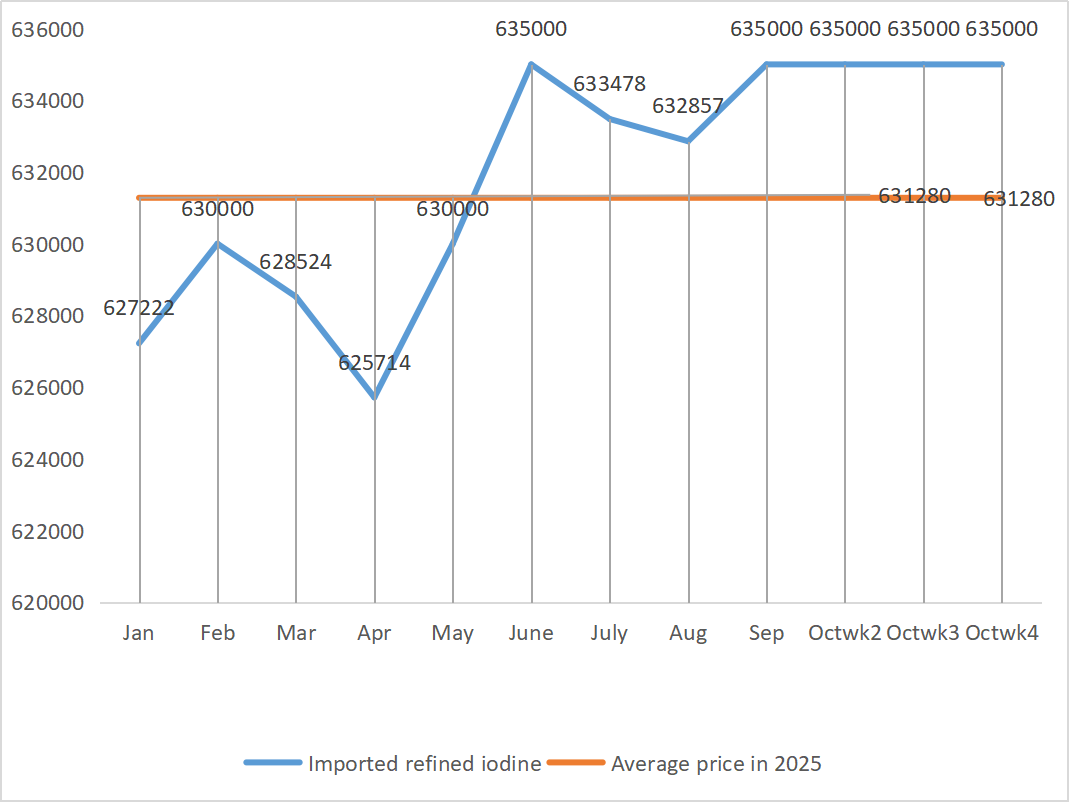Trace Elements Market Analysis
I,Analysis of non-ferrous metals
Week-on-week: Month-on-month:
| Units | Week 2 of October | Week 3 of October | Week-on-week changes | September average price | As of October 24
Average price |
Month-on-month change | Current price as of October 28 | |
| Shanghai Metals Market # Zinc ingots | Yuan/ton |
21968 |
21930 |
↓38 |
21969 |
21983 |
↑14 |
22270 |
| Shanghai Metals Market # Electrolytic Copper | Yuan/ton |
85244 |
85645 |
↑401 |
80664 |
85572 |
↑4908 |
87906 |
| Shanghai Metals Australia
Mn46% manganese ore |
Yuan/ton |
40.51 |
40.55 |
↑0.04 |
40.32 |
40.50 |
↑0.18 |
40.45 |
| The price of imported refined iodine by Business Society | Yuan/ton |
635000 |
635000 |
635000 |
635000 |
|
635000 |
|
| Shanghai Metals Market Cobalt Chloride
(co≥24.2%) |
Yuan/ton |
100060 |
104250 |
↑4190 |
69680 |
100196 |
↑30516 |
105000 |
| Shanghai Metals Market Selenium Dioxide | Yuan/kilogram |
105 |
107.5 |
|
103.64 |
106.04 |
↑2.4 |
107.5 |
| Capacity utilization rate of titanium dioxide manufacturers | % |
77.85 |
77.44 |
↓0.41 |
76.82 |
77.86 |
↑1.04 |
|
1)Zinc sulfate
① Raw materials: Zinc hypooxide: The transaction coefficient keeps hitting new highs for the year.
Basis zinc price: On the macro level, the weakening of geopolitical influence and the cooling of risk aversion sentiment, on the fundamentals, the low overseas inventory and the continuous decline of domestic processing fees have always supported zinc prices. However, after the export window opens, the domestic zinc ingot export volume is relatively limited and the pattern of oversupply is difficult to change. It is expected that zinc prices will remain stable in the short term, with an operating range of 21,900-22,400 yuan per ton.
② Sulfuric acid prices remain stable at high levels across the country. Soda ash: Prices were stable this week.
On Monday, the operating rate of water zinc sulfate producers was 89% and the capacity utilization rate was 74%, remaining flat compared with the previous week. Major manufacturers have placed orders until mid-November.
This week, the order continuity of manufacturers was decent, remaining at around one month. After a slight drop in prices last week, but with firm raw material costs, it is expected that prices will remain weak and stable later. Customers are advised to purchase on demand.
2)Manganese sulfate
In terms of raw materials: ① The manganese ore market was stable with a slight fluctuation and rebound at the beginning of the week. With a slight increase in overseas futures prices, the price of South African semi-carbonate manganese ore gradually rebounded. However, the downstream alloy market remained weak and stable, leading factories to be cautious about raw material procurement, and the overall ore price fluctuation was relatively limited.
② Sulfuric acid remained stable at a high level this week.
This week, the operating rate of manganese sulfate producers was 76%, down 14% from the previous week; Capacity utilization was 53%, down 7% from the previous week. Major manufacturers are scheduled until mid to late November. Manufacturers hover around the production cost line, and prices are expected to remain stable. Delivery tensions ease and supply and demand are relatively stable. Based on the analysis of enterprise order volume and raw material factors, manganese sulfate will remain at a high and firm price in the short term, with manufacturers hovering around the production cost line. It is expected that the price will remain stable and customers are advised to increase inventory appropriately.
3)Ferrous sulfate
In terms of raw materials: Demand for titanium dioxide remains sluggish, and the operating rate of titanium dioxide manufacturers is low. Ferrous sulfate heptahydrate is a product in the titanium dioxide production process. The current situation of manufacturers directly affects the market supply of ferrous sulfate heptahydrate. Lithium iron phosphate has a stable demand for ferrous sulfate heptahydrate, further reducing the supply of ferrous sulfate heptahydrate to the ferrous industry.
This week, the operating rate of ferrous sulfate producers was 75%, the capacity utilization rate was 24%, unchanged from the previous week, and producers’ orders were scheduled until November. Although ferrous sulfate heptahydrate is still in short supply, some manufacturers have overstocked inventories of finished ferrous sulfate, and it is not ruled out that prices will drop slightly in the short term.
It is suggested that the demand side make purchasing plans in advance in light of inventory.
4)Copper sulfate/basic copper chloride
In terms of raw materials: Copper prices rose and then fluctuated. China and the US resumed negotiations. Tariff pressure eased slightly. The US government remains shut down. Employment data has not been released. Although Powell’s dovish stance has led to expectations of rate cuts, the window period of macro event disturbances is not over yet. Pay attention to the interest rate meeting. There is no news of resumption of production at the Grasberg copper mine. There are more disturbances at the mine end and the smelting profit environment is harsh. The path from tight copper supply to reduced smelting capacity is not smooth. Downstream consumption reception is the core variable. Currently, consumption during the traditional peak season is less than last year.
On the macro level, optimism in Sino-US negotiations and supply shortages have boosted the outlook for metal demand. The Sino-US economic and trade consultations began on the 24th. The market expects the trade war to be postponed, and investors’ risk appetite has warmed up, pushing up expectations for metal market demand. Copper futures prices have risen as a result, hitting a new high since late May last year and performing strongly. The persistent shortage of supply from major overseas mines has intensified concerns, and the International Copper Research Group (ICSG) has lowered its forecast for copper supply growth in 2025 to 1.4%, lower than its previous expectation of 2.3%. Strong demand from China and around the world has led to a widening supply gap. Trading sentiment in the spot market has improved, and with the possibility of overseas hoarding, copper prices are expected to remain high and volatile. Copper price range for the week: 87,620-88,190 yuan per ton.
Etching solution: Some upstream raw material manufacturers have accelerated capital turnover by deep processing etching solution into sponge copper or copper hydroxide. The proportion of sales to the copper sulfate industry has decreased, and the transaction coefficient has reached a new high.
Copper prices remained stable at a high level this week. Against the backdrop of high copper network prices, downstream customers purchased as needed.
5)Magnesium sulfate/magnesium oxide
Raw materials: The price of sulfuric acid is rising in the north at present.
At present, factory production and delivery are normal. The magnesia sand market is mainly stable. Downstream consumption of inventory is the main factor. Demand is expected to gradually recover in the later period, which will support the market price. The market price of light-burned magnesia powder is stable. Subsequent capacity control involved: elimination of reaction boilers in magnesium oxide factories. It is expected that the price will continue to rise after November. In the short term, the price of magnesium sulfate/magnesium oxide may increase slightly. It is recommended to stock up appropriately.
6)Calcium iodate
Raw materials: The domestic iodine market is stable at present, the supply of imported refined iodine from Chile is stable, and the production of iodide manufacturers is stable.
Calcium iodate producers were operating at 100% this week, unchanged from the previous week; Capacity utilization was 34%, down 2% from the previous week; Quotations from major manufacturers remained stable. The price of refined iodine rose slightly in the fourth quarter, the supply of calcium iodate was tight, and some iodide manufacturers were shut down or limited production. It is expected that the general tone of a steady and slight increase in iodide prices will remain unchanged. It is recommended to stock up appropriately.
7)Sodium selenite
In terms of raw materials: Supported by tight raw material prices and positive downstream demand, some manufacturers have suspended their quotations to the outside, leading to a temporary tight market supply and driving the prices of selenium powder and selenium dioxide to remain strong.
The price of selenium rose last Tuesday. Market insiders said that the market price of selenium was stable with an upward trend, trading activity was average, and the price was expected to remain strong in the later period. Sodium selenite producers say demand is weak, costs are rising, orders are increasing, and quotations are rising this week. It is expected that prices will strengthen in the short term. Clients are advised to purchase according to their own inventory.
8)Cobalt chloride
In terms of raw materials: Upstream smelters and traders are in a wait-and-see mood, and the market has suspended quotations against the backdrop of most companies halting quotations and prices continuing to rise. On the demand side, since the release of the export ban in the Democratic Republic of the Congo on September 22, there has been a period of panic in the market. Affected by the weakening demand expectations for the end of the year and next year, the purchasing behavior of downstream enterprises has become more cautious.
This week, cobalt chloride producers were operating at 100%, with capacity utilization at 44%, remaining flat compared to the previous week. Due to rising raw material prices, the cost support for cobalt chloride raw materials has strengthened, and it is expected that prices will rise further in the future.
It is recommended that the demand side make purchase and stockpiling plans in advance based on inventory conditions.
9)Cobalt salts/potassium chloride/potassium carbonate/calcium formate/iodide
1. Cobalt salts: Raw material costs: Significantly increased market activity for cobalt salts. The transaction price was slightly lower than the market expectation earlier, the downstream purchasing pace slowed, and the wait-and-see sentiment rose. Cobalt salt prices are likely to remain high and volatile in the short term, waiting for further release of demand. In the medium to long term, the supply shortage caused by the quota system in the Democratic Republic of the Congo, coupled with the growth in demand for new energy, still has upside potential for cobalt salt prices. Stock up appropriately based on demand.
- Potassium chloride: The market remained weak last week, with rumors of a halt in border trade potassium imports, a slight increase in potassium chloride, and a rise in potassium chloride port inventories, but there is still a gap to watch the continuous arrival volume. Keep an eye on winter storage demand, or start in November, and pay attention to the urea market. It is recommended to stock up appropriately.
3. Calcium formate prices continued to decline this week. Raw formic acid plants resume production and now increase factory production of formic acid, leading to an increase in formic acid capacity and an oversupply. In the long term, calcium formate prices are falling.
4 Iodide prices were stable this week compared to last week.
Post time: Oct-31-2025










